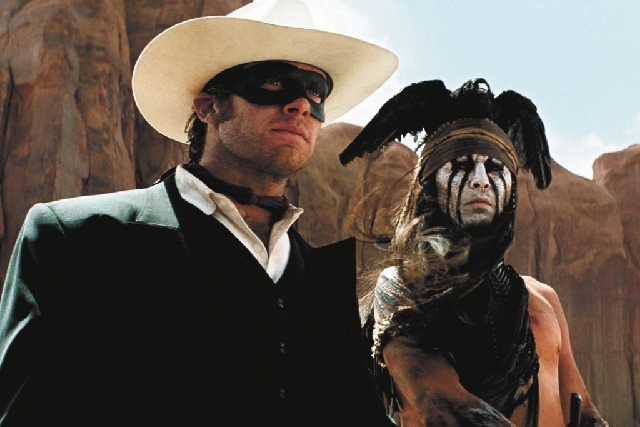‘The Lone Ranger’ plays second fiddle to offbeat Tonto

The Lone Ranger is a spirit walker whose life can’t end in battle.
“The Lone Ranger” is a bloated spectacle whose running time can’t end soon enough.
The movie’s main selling point — perhaps its very reason for being — is that it comes from the team behind “Pirates of the Caribbean.” But even if this weren’t beaten to death in every piece of its marketing, it wouldn’t take moviegoers long to catch on.
Just like Johnny Depp’s Jack Sparrow, his Tonto is an offbeat nomad. They both wear eyeliner, bandanas and braids and beads in their hair. Sparrow clings to a seemingly useless compass; Tonto clings to a seemingly useless pocket watch. If somebody at Disney didn’t misguidedly think “The Lone Ranger” still had some sort of name recognition among that elusive young-male demographic, they might as well have called it “Tonto of the Caribbean.”
But if it comes from the team behind “Pirates” — Depp, director Gore Verbinski, producer Jerry Bruckheimer and writers Ted Elliott and Terry Rossio (who share credit here with “Snitch’s” Justin Haythe) — it also comes from the team behind its progressively worse sequels. (Only Verbinski didn’t return for the dreadful “On Stranger Tides.”)
“The Lone Ranger” continues their cycle of diminishing returns.
Tonto and fancy East Coast lawyer John Reid (Armie Hammer) meet on a train bound for Colby, Texas, in 1869. Reid is studying John Locke amid a gaggle of singing Presbyterians; Tonto is chained next to the dastardly Butch Cavendish (William Fichtner). The two reluctantly join forces during an escape pulled off by Cavendish’s bland band of outlaws.
Reid doesn’t believe in guns. Well, presumably he believes they exist, just not in using them. But he’s soon deputized as a Texas Ranger by his revered older brother Dan (James Badge Dale) before setting off in his shiny new white hat as part of an eight-member posse to bring Cavendish to justice.
As for what happens next, for you spoilerphobes out there, let’s just say there’s a reason the movie isn’t called “The Eight Rangers.”
Following an ambush, a white “spirit horse” shows up and decides, much to Tonto’s disbelief, that John, not his heroic brother, is destined to be a “spirit walker” who will be brought back from the other side.
From there, the mismatched duo sets off in search of Cavendish — Reid, for what he did to Dan, and Tonto for the atrocities Cavendish committed against the Comanches 26 years earlier.
There are plenty of departures along the way. Political shenanigans involving a greedy railroad man (Tom Wilkinson). Dan’s always-in-peril widow (Ruth Wilson) and son (Bryant Prince). A shady cavalry officer (Barry Pepper). Helena Bonham Carter even turns up as a one-legged madame because, after appearing together in five previous movies, she and Depp are practically a package deal.
Depp gives the role of Tonto his quirky best, forever “feeding” the dead crow he wears as a hat, among other eccentricities. But that only goes so far.
He’s one of my absolute favorite people in Hollywood. Heck, we were born in the same relatively small hospital. But after his overreliance on misfits and oddballs, it would be so refreshing to see Depp as a regular, 21st century guy. In something other than “The Tourist.”
Hammer does what he can with the underwritten role of Reid, ever-so-slowly transitioning from nervous fussbudget to legendary hero. But for long stretches, he’s little more than a bystander in his own story.
And the movie’s framing device — an elderly Tonto tells his story to an inquisitive young visitor (Mason Cook) at a Wild West Exhibition in 1933 San Francisco — is not only unnecessary, it proves a distraction as the numerous cutaways disrupt whatever flow “The Lone Ranger” manages to muster.
All the familiar hallmarks are accounted for. The mask. The silver bullet. Kemosabe. The six-shooters that only need reloading in those rare instances when the plot dictates.
Unlike “Man of Steel,” this summer’s other too-long origin story of a 1930s action hero, at least “The Lone Ranger” remembered to use its iconic music.
And seeing a big-screen Western full of horses, trains and spectacular vistas never gets old. Even if this particular Western treats those trains the way the “Fast and Furious” franchise treats cars: with little respect or knowledge of physics.
But with a reported budget of $250 million, “The Lone Ranger” ultimately feels like an extravagant noise in search of an audience.
Although if you were a fan of “Pirates” but felt that Sparrow fellow had a bit too much charisma, it just may be the diversion for you.
Contact Christopher Lawrence at clawrence@
reviewjournal.com or 702-380-4567.